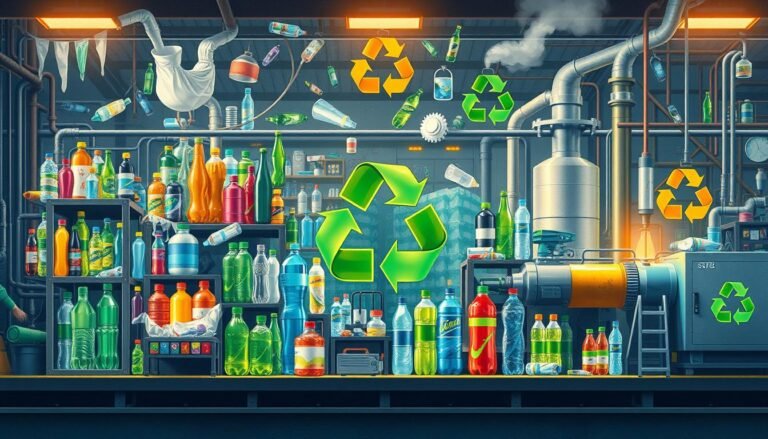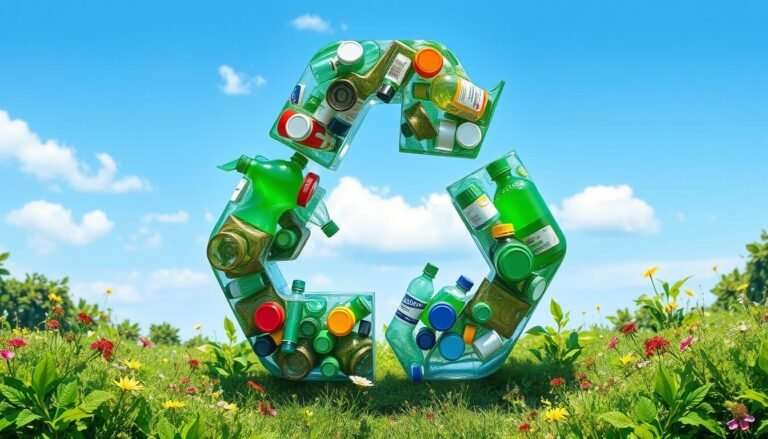Внесите некоторые изменения в окружающую среду
-
Здание 3, Wanyang Innovation City, улица Langxia, город Юйяо, провинция Чжэцзян
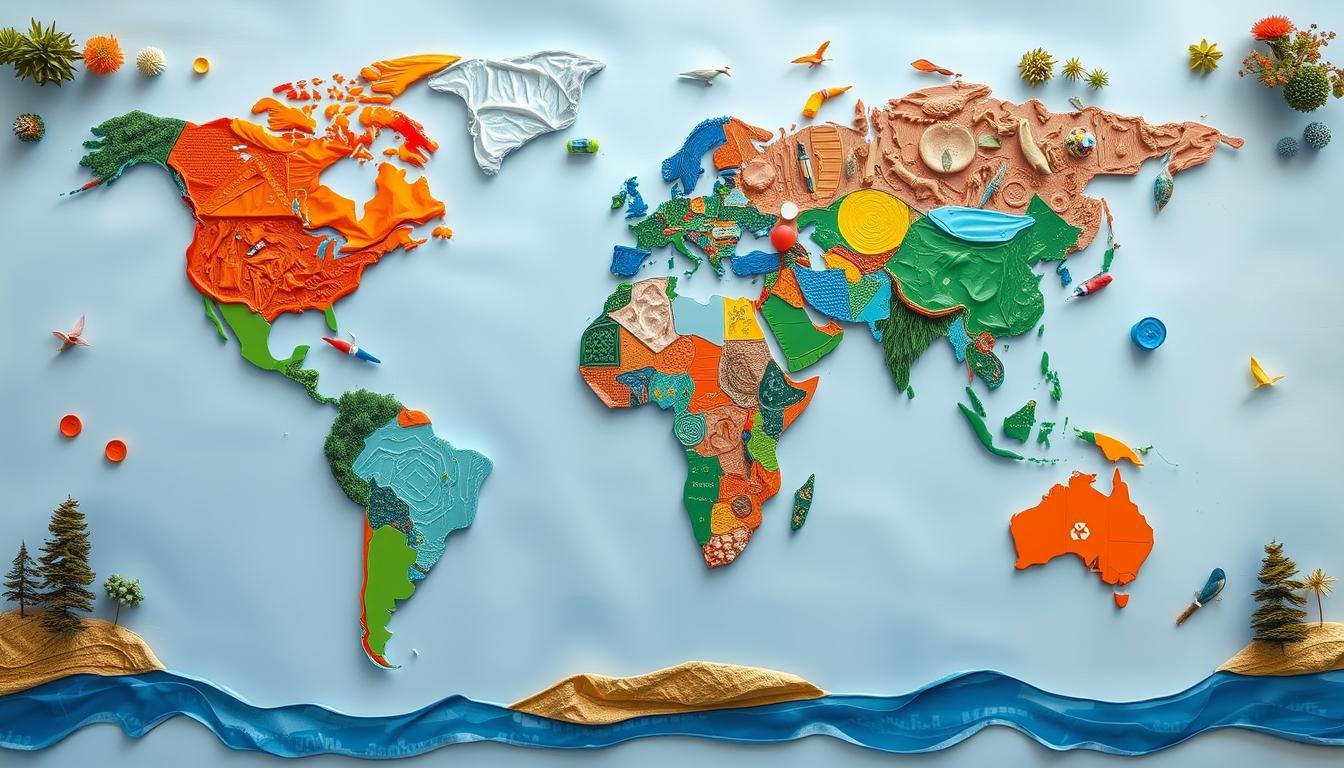
Показатели переработки: Сколько пластика перерабатывается?
Знаете ли вы, что правда о переработке пластика весьма шокирующая? Исследования показывают, что большинство пластиковых изделий не перерабатывается. На самом деле, только 9% всего пластика успешно перерабатывается во всем мире. Остальные 91% либо сжигаются, либо выбрасываются на свалки, либо наносят вред окружающей среде.1. Такая большая разница между тем, на что мы надеемся, и тем, что происходит на самом деле, говорит о том, что нам необходимо внимательно изучить способы переработки. Для борьбы с растущей проблемой пластиковых отходов важно знать, почему уровень переработки так низок.
Некоторые страны перерабатывают пластик лучше, чем другие. Южная Корея перерабатывает около 34% своего пластика, а Китай - более 31%.1. Однако другие страны значительно отстают. Например, уровень переработки в США в 2021 году снизился примерно до 5%.2. Такие низкие показатели оказывают большое влияние как на природу, так и на нашу экономику. Эксперты считают, что к 2050 году количество пластикового мусора на свалках может быть таким же тяжелым, как 36 000 зданий Эмпайр-стейт-билдинг.1. Эта тревожная информация показывает, что нам нужны лучшие способы обращения с пластиковыми отходами.
Узнайте больше об устойчивом развитии здесь
Основные выводы
- Только 9% мирового объема пластика перерабатывается, а 91% попадает на свалку, сжигается или загрязняет окружающую среду.1.
- Уровень переработки пластика в США снизился до 5% в 2021 году2.
- Южная Корея и Китай перерабатывают примерно 34% и 31% своих пластиковых отходов, соответственно.1.
- К 2050 году на свалках может скопиться 12 миллиардов метрических тонн пластиковых отходов1.
- Эффективный утилизация пластиковых отходов имеет решающее значение для экологии устойчивость в переработке отходов усилия.
Глобальный ландшафт производства пластмасс
В мире производится много пластика, и это количество продолжает расти. Мы рассмотрим, сколько пластика мы производим и что это значит для планеты. Проблема одноразового использования пластика очень велика, она вызывает беспокойство у природы и приводит к изменениям в бизнесе.
Годовая статистика производства пластмасс
С 1950 по 2021 год производство пластика выросло с 2 миллионов тонн до более чем 400 миллионов тонн3. К сожалению, во всем мире перерабатывается менее 10% пластика.3. Нам срочно нужны более совершенные методы переработки и более сильный рынок для вторичных товаров. Огромная часть пластика 90% производится из ископаемого топлива, что еще больше затрудняет его переработку3. Но будущее переработанной пластмассы выглядит более радужно: ожидается, что к 2032 году ее стоимость достигнет 107,13 миллиарда долларов США.4.
Рост популярности одноразовых пластиков
Большинство пластика сегодня, около 90%, является новым и дешевым в производстве3. Это приводит к еще большему загрязнению окружающей среды, поскольку пластик быстро выбрасывается. Отходы от одноразового использования пластика трудно утилизировать, что еще больше вредит нашей планете. Переработанный ПЭТ, используемый в основном в бутылках и пищевой упаковке, составляет большую часть рынка переработанного пластика в 2023 году4.
Прогнозируемый рост производства пластмасс
Производство пластика может утроиться к 2060 году3. Нам нужны глобальные действия, чтобы справиться с растущим количеством пластиковых отходов и их вредом для окружающей среды. К 2050 году при производстве и сжигании пластика может выделяться столько же CO2, сколько за год выбрасывают 615 крупных угольных электростанций5. Кроме того, планируется значительный рост производства пластиков ПВД и ПП, поскольку они полезны и лучше для окружающей среды.4.
Влияние пластиковых отходов на окружающую среду
Пластиковые отходы - огромная проблема для нашей планеты. Он вредит и суше, и морю. Мы должны действовать быстро, чтобы остановить загрязнение пластиком.
Загрязнение океанов пластиком
Ежегодно в океаны попадает от 1 до 2 миллионов тонн пластика. Это примерно 0,5% всех пластиковых отходов.6. Такое загрязнение наносит огромный вред морской флоре и фауне. В основном оно поступает из стран со средним уровнем дохода в Азии6. Пластик в океане вредит морским животным и нарушает их жилище.
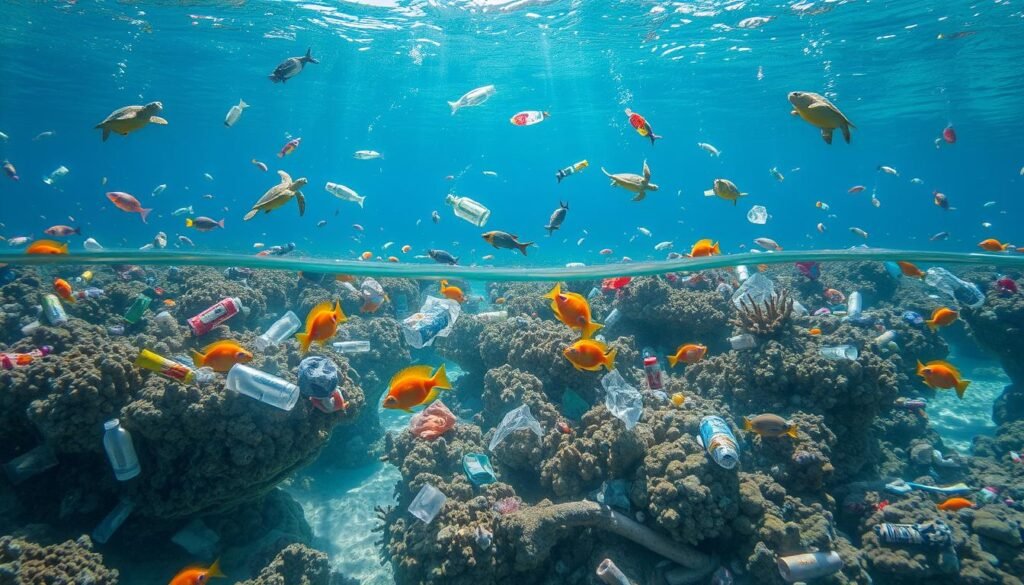
Микропластик: Скрытая угроза
Микропластик - крошечный, но очень важный. Они попадают в почву, воду и даже в воздух.7. Эти маленькие кусочки содержатся во многих продуктах питания.7. Они могут причинить вред как людям, так и животным.
Воздействие на морскую и наземную жизнь
Пластиковые отходы смертельно опасны для животных на суше и в море. Они могут съесть его или попасть в него. Это приводит к серьезным повреждениям или даже к смерти. Пластмасса может сильно испортить их здоровье7.
Исследования показывают, что микропластик опасен и для нас. Они могут влиять на наши гормоны и вызывать рак7. Мы должны остановить это загрязнение, чтобы защитить наше здоровье и планету.
К сожалению, мы перерабатываем только 9% всех пластиковых отходов.8. Большинство из них попадает на свалки или выбрасывается неправильно. Нам нужны лучшие способы обращения с отходами. В борьбе с загрязнением пластиком ключевую роль играют мировые усилия.
мировое производство пластмасс6.
Современные методы переработки отходов в мире
В разных странах мира переработка пластика происходит по-разному, в зависимости от местных правил, инфраструктуры и стоимости. Во всем мире перерабатывается только около 9% пластиковых отходов. Это говорит о том, что нам нужны более совершенные технологии и системы переработки, чтобы справиться с растущим объемом пластиковых отходов9.
Показатели переработки отходов по странам
В США перерабатывается только 21% вторсырья из домов. При этом 73% домов могут быть переработаны10. Большинство вторсырья, 76%, попадает в мусор10. В таких странах, как Германия и Швейцария, дела обстоят гораздо лучше: там перерабатывается более половины отходов.9.
Проблемы переработки различных видов пластика
Сортировать пластики сложно, потому что они очень сильно различаются. Больше всего перерабатывается ПЭТ (код смолы #1) и ПЭНД (код смолы #2). Их можно найти в таких предметах, как бутылки для напитков и контейнеры для молока.9.
Пластмассы с кодами смолы от #3 до #7 сложнее перерабатывать. Они имеют сложную структуру и не стоят больших денег9. Кроме того, большинство пластиков можно переработать лишь несколько раз, после чего они становятся непригодными. Они оказываются на свалках или сжигаются9.
Влияние переработки на углеродный след
Переработка помогает сократить углеродный след, связанный с производством и утилизацией пластика. При этом меньше пластика отправляется на свалки и сжигается, что снижает выбросы парниковых газов. Тем не менее, мы должны делать это лучше. Законы о расширенной ответственности производителя (EPR) в таких местах, как Калифорния, помогают в этом. Они увеличивают объем переработки и сокращают выбросы углекислого газа.10.
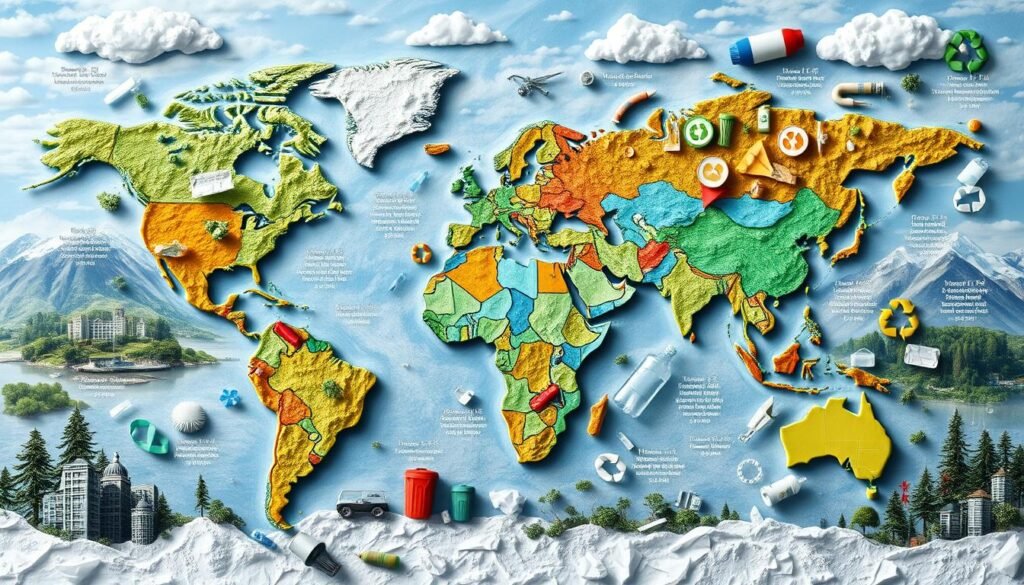
Почему большинство пластика не перерабатывается
Большинство пластика не перерабатывается, потому что это сложно и нерентабельно. Около 91% пластиковых отходов не перерабатывается, что свидетельствует о слабости наших систем переработки11. Мы обнаружили, что 75% произведенных пластмасс - это термопласты, которые мы теоретически можем переработать. Остальные 25% - это термореактивные пластмассы, которые мы не можем легко переработать.11.
Виргинский пластик зачастую дешевле переработанного. Это делает компании менее заинтересованными в переработке12. Например, изготовление вещей из переработанного пластика зачастую обходится дороже, чем из нового.12.
Переработка пластика - сложная задача, поскольку для ее решения требуется современное оборудование для сортировки и переработки. В некоторых регионах без такого оборудования мы просто выбрасываем пластик или сжигаем его11. Кроме того, даже если мы правильно сортируем вторсырье, оно может не попасть на переработку из-за плохой инфраструктуры.12.
Около 85% пластиковой упаковки оказывается на свалках12. Проблема усугубляется тем, что многие виды пластика не представляют особой ценности для переработки. Например, пластик с маркировкой #3-7 практически никогда не перерабатывается, потому что он не представляет особой ценности12. Даже когда технологии переработки становятся все лучше, деньги и технические проблемы стоят на пути к переработке большего количества пластика.
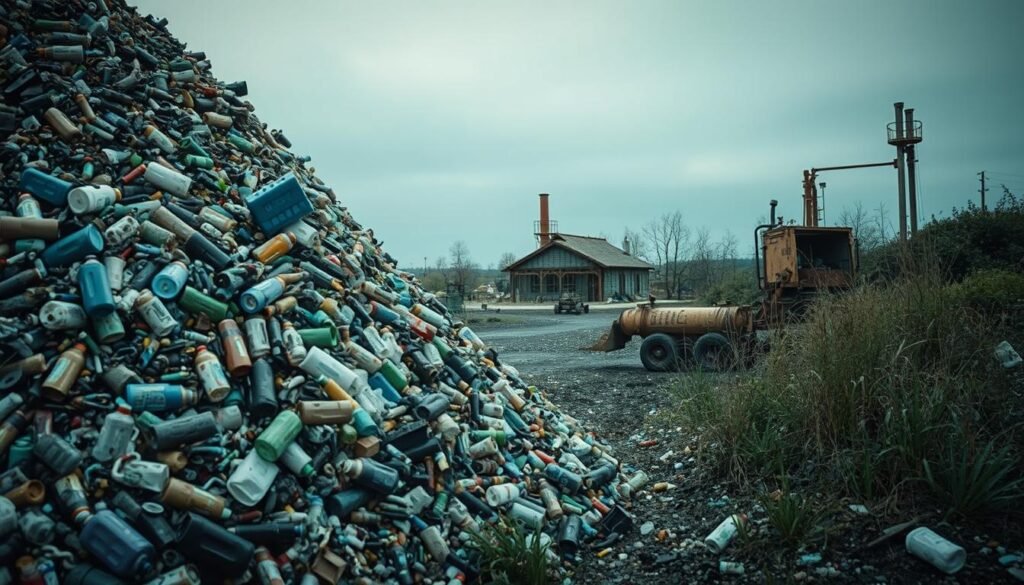
Нам нужно вкладывать деньги в новые технологии переработки отходов и разрабатывать политику, направленную на решение этих проблем. Также важно научить людей больше перерабатывать и улучшить систему обращения с отходами. Таким образом, мы сможем перерабатывать больше пластика. Чтобы узнать больше о том, как лучше перерабатывать отходы, ознакомьтесь с Решения по переработке ПНД ради лучшего будущего11.
Экономические факторы, влияющие на уровень переработки отходов
Экономика переработки отходов может быть непростой задачей, так как на нее влияет множество факторов. Один из главных вопросов - стоимость видов пластика. Древний пластик зачастую дешевле переработанного. Это происходит в основном потому, что крупномасштабное производство и субсидии благоприятствуют изготовлению нового пластика.
Стоимость натурального пластика по сравнению с переработанным пластиком
Виргинский пластик обычно стоит дешевле, чему способствует большая финансовая поддержка. Эта поддержка делает его дешевле, несмотря на то что он хуже для планеты13. Кроме того, при производстве нового пластика не требуется дополнительных операций, как при производстве переработанного. Эти этапы включают сортировку, очистку и переработку. Эта разница в процессе помогает снизить стоимость. К сожалению, в США перерабатывается только 8,7% пластика, отчасти из-за этих затрат.13.
С другой стороны, переработка может стоить дороже, но у нее есть свои плюсы. Например, при переработке алюминия расходуется на 95% меньше энергии, чем при производстве нового.14. Эти преимущества подчеркивают экономическую и экологическую выгоду от переработки отходов.
Субсидии и их роль
Государственные субсидии оказывают большое влияние на экономика переработки. Они в основном помогают производству первичного пластика, оставляя переработку за бортом. Если бы рециклинг пользовался большей поддержкой, его показатели могли бы резко возрасти. Ключевым моментом является повышение экономической привлекательности вторичного сырья.
В некоторых областях влияние субсидий на переработку хорошо изучено. США могли бы сократить выбросы на 25%, если бы все пластмассы перерабатывались13. Такие шаги показывают ценность стимулирования переработки с помощью субсидий.
Если посмотреть на ситуацию в целом, то правильная поддержка может сотворить чудеса. Более эффективные субсидии на переработку отходов могут повысить показатели и сократить наш углеродный след. Таким образом, корректировка финансовой поддержки переработки необходима для более экологичного будущего.
Как реагируют компании и правительства
Компании и правительства повсеместно решают проблему пластиковых отходов. Они предпринимают серьезные шаги, например, запускают проекты по устойчивому развитию и вводят новые правила. Их действия свидетельствуют о сильном желании построить лучшее, более устойчивое будущее.
Корпоративные инициативы в области устойчивого развития
Предприятия принимают политика устойчивости упростить переработку и использовать больше вторичных материалов. Такие крупные компании, как Unilever и Coca-Cola, пообещали к 2025 году использовать в своей упаковке больше переработанных материалов.15. Они также вкладывают деньги в новые технологии переработки отходов для производства новых пластиков, хотя некоторые люди задаются вопросом, действительно ли эти методы полезны для планеты.16.
Политические усилия и нормативные акты
Правительства устанавливают жесткие правила политические усилия для борьбы с проблемой пластиковых отходов. Например, Европейский союз хочет, чтобы к 2030 году вся пластиковая упаковка была пригодна для вторичной переработки.15. Соединенные Штаты стараются меньше использовать одноразовые пластики и лучше перерабатывать их17. Эти действия направлены на то, чтобы изменить систему к циркулярной экономике, сократить количество пластиковых отходов на свалках и в океанах.
Глобальные договоры и соглашения
Совместная работа над глобальные договоры и соглашения является ключом к борьбе с загрязнением пластиком. Группы и страны присоединяются к глобальным соглашениям, таким как Базельская конвенция, и теперь уделяют особое внимание управлению пластиковыми отходами через границы17. Эта совместная работа направлена на улучшение качества переработки и утилизации пластиковых отходов во всем мире. Ассамблея ООН по окружающей среде также настаивает на заключении всемирного соглашения по борьбе с пластиковыми отходами, нацеленного на значительные изменения во многих странах16.
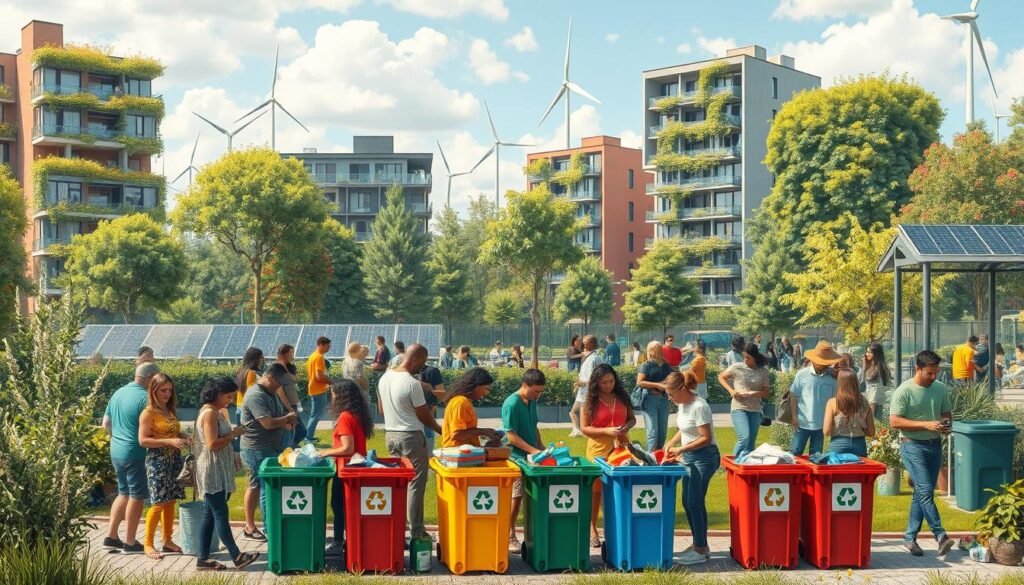
Корпоративные инициативы по переработке отходов и поддержка правил глобальные экологические сделки. Эта совместная работа подчеркивает важность устойчивого развития, повышая шансы на создание циркулярной экономики. Такие совместные действия крайне важны для уменьшения негативных последствий пластиковых отходов и защиты нашей планеты для всех в будущем15.
Восприятие и поведение населения в отношении переработки отходов
Мнения и действия людей сильно влияют на уровень переработки отходов. Понимание и действия по переработке отходов могут помочь или навредить этим усилиям. Мы должны повышать осведомленность и прояснять распространенные заблуждения, чтобы поощрять экологически безопасные действия.
Заблуждения потребителей
Многие люди не знают, что новый пластик получают из сырой нефти. Удивительно, но 69% американцев не осознают этого, а 93% думают, что перерабатывается больше пластика, чем на самом деле18. Такое непонимание приводит к неправильному выбору способа утилизации и снижению объема переработки. Кроме того, 63% человек путают этикетки о переработке с надписями на товарах.19.
Повышение осведомленности общественности
Для исправления этих ложных убеждений необходимо более качественное образование и четкая подача информации. В этом могут помочь четкие этикетки и информационные кампании. Например, 78% американцев проверяют информацию об утилизации на продуктах, чтобы правильно их утилизировать, и 82% считают эту информацию точной.19. Использование этого факта в наших интересах может повысить успешность переработки. Кроме того, 71% американцев ежегодно беспокоятся о пластиковых отходах на свалках или в мусоросжигательных печах, что свидетельствует о необходимости более активного просвещения.18.
Повышение уровня информированности населения может сделать системы утилизации более эффективными. Около 30% американцев утверждают, что их община активно поддерживает переработку отходов20. Такое поощрение со стороны местных лидеров может подтолкнуть людей к более активной переработке отходов.
Чтобы улучшить переработку отходов, мы должны сосредоточиться на просвещении людей и четком общении. Понимание и исправление неверных представлений о переработке может привести к формированию лучших привычек. Поддержка цикла повторного использования - ключ к экологичному будущему19. Нажмите здесь чтобы узнать больше.
Инновационные решения и технологии в области рециклинга
Для повышения эффективности переработки отходов важно уделять внимание новым технологиям. Эти инновации помогают сделать переработку более эффективной и действенной. Они имеют решающее значение для развития циркулярной экономики и обеспечения более качественной переработки пластмасс.
Достижения в области технологий переработки отходов
Технологии переработки отходов значительно продвинулись вперед. За последние пять лет рынок новых методов переработки быстро расширился. Они предлагают решения проблем, с которыми сталкивается традиционная переработка. В тройку лидеров среди новых методов переработки входят пиролиз, деполимеризация и растворение в растворителе.21. Пиролиз занимает лидирующие позиции при большой поддержке нефтегазовых компаний. Такие компании, как LyondellBasell и SK, используют его для производства пиролизного масла - альтернативы топливу21.
Традиционная механическая переработка имеет такие проблемы, как дорогостоящая сортировка и ограниченное количество видов принимаемого пластика. Загрязнения также часто становятся причиной отказов. Этот метод может привести к получению низкокачественной продукции и является более дорогостоящим, чем производство нового пластика. Фактически, использование переработанного ПЭТ может быть примерно на 10% дороже, чем новый пластик.21. Но новые технологии, такие как растворение в растворителе, могут решить эти проблемы. Она потребляет меньше энергии и лучше для окружающей среды21.
Разработка моделей циркулярной экономики
Циркулярная экономика помогает и окружающей среде, и экономике. Она направлена на то, чтобы пластик служил дольше благодаря эффективной переработке и повторному использованию. Это значительно снижает вред, наносимый окружающей среде. Примером может служить технология PureCycle по очистке использованного полипропилена. Их завод в Огайо будет перерабатывать 119 миллионов фунтов в год. Это большой шаг к повторному использованию полипропилена, в котором нуждается Северная Америка и который в 2012 году составлял около 1 миллиарда фунтов.22.
Такие компании, как Coca-Cola и Nestle, вкладывают деньги в переработку, чтобы использовать меньше нового пластика. Это поддерживает цели циркулярной экономики. В настоящее время перерабатывается менее 10% пластика. А из полипропилена, второго по использованию пластика в мире, перерабатывается только 1%.22.
Сколько пластика перерабатывается?
Несмотря на все наши старания, правда о переработке пластика не очень хороша. Во всем мире перерабатывается только 9% пластика. Остальное выбрасывается, сжигается или закапывается на свалках.1. В США уровень переработки даже снизился с 8,7% в 2018 году до примерно 5% в 2021 году.1. Такие страны, как Южная Корея и Китай, работают лучше, перерабатывая 34% и более 31% своих пластмасс, соответственно.1.
В Европе эти показатели сильно различаются. На первом месте находятся Ирландия и Германия, где ежегодно перерабатывается около 20,70 кг и 19,98 кг пластика на человека.1. Великобритания отстает, перерабатывая всего 17% пластиковых отходов в год.1.
Если рассматривать различные типы пластмасс, то мы видим, что 30% из типов 1 и 2 (ПЭТ и ПЭНД) перерабатывается23. Но переработать типы с 3 по 7 гораздо сложнее, особенно типы 6 и 7, которые практически невозможно переработать23. Это говорит о том, что из-за нынешних систем и технологий существует большая проблема с переработкой отходов.
Сравнение с другими материалами показывает разительную разницу. В Германии и Швейцарии перерабатывается около 90% стекла, в то время как в США - только 30%.23. Кроме того, в США используется около 75% всего когда-либо произведенного алюминия, что позволяет сэкономить много энергии по сравнению с производством нового алюминия.23. Эти факты подчеркивают, насколько лучше мы могли бы работать с пластиком.
Чтобы действительно изменить ситуацию, нам необходимо изменить нашу политику и наши действия. Глобальный договор по пластику предлагает сократить производство пластика из ископаемого топлива на 60% к 2040 году. Этот план направлен на устранение основной причины пластиковых отходов, а не только на их переработку23.
Таким образом, для повышения уровня переработки пластика и эффективности его использования во всем мире требуется всеобщая работа. Нам нужны новые правила, технический прогресс, обучение людей и ответственность компаний.
Заключение
Для защиты нашего будущего крайне важно преодолеть кризис загрязнения пластиком. Переработка пластика экономит много энергии: 79% для ПЭТ, 88% для ПЭНД и 88% для ПП. Это показывает, почему нам нужны более совершенные технологии переработки24. Переработка этих материалов также значительно сокращает выбросы в атмосферу по сравнению с новыми материалами: 67%, 71% и 71%, соответственно.24. Однако успех вторичной переработки зависит от того, насколько хорошо мы справляемся с пластиковыми отходами. Это большая проблема в странах с низким уровнем доходов.6.
Чтобы справиться с растущим количеством пластика, нам нужны всемирные правила. Производство пластика выросло с 2 миллионов тонн в 1950 году до более чем 450 миллионов тонн в настоящее время.6. Ожидаемое увеличение объема пластика в США на 90% к 2060 году показывает, что мы должны найти новые способы уменьшения отходов25. Повышение осведомленности людей и изменение нашего отношения к переработке может увеличить количество перерабатываемых отходов. Это поможет сократить количество пластика на свалках и в океанах6.
Мы все должны работать вместе, чтобы улучшить технологии переработки, стратегии утилизации отходов и разработку политики. Это поможет нам лучше управлять пластиком в глобальном масштабе. Заглядывая в будущее, предприятия и правительства должны работать вместе, чтобы уменьшить вред, наносимый окружающей среде. Решив эту проблему со всех сторон, мы сможем сократить глобальное количество пластиковых отходов. Это сделает нашу планету чище и безопаснее для следующих поколений.


